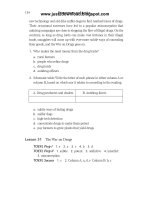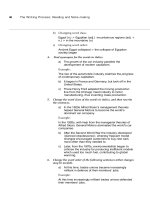Tài liệu Academic Writing A Handbook for International Students part 2 docx
Bạn đang xem bản rút gọn của tài liệu. Xem và tải ngay bản đầy đủ của tài liệu tại đây (173.2 KB, 10 trang )
Student Introduction
Most academic courses in English-medium colleges and
universities use essays or other written tasks to assess students’
work. These can be done as coursework, when a deadline of one
or two months may be given, or in exams, when an essay often
has to be finished in an hour.
The process of writing essays for coursework can be shown as a
flowchart:
Understand essay title/requirements
Assess reading texts – choose most suitable
Select relevant areas of texts – keep record for references
Make notes on relevant areas, using paraphrasing and
summarising skills
Combine a variety of sources where necessary
Select suitable structure for essay – make plan
Organise and write main body
Organise and write introduction
Organise and write conclusion
Critically read and rewrite where necessary
Final proof-reading
Part 1, The Writing Process, examines each of these stages in turn.
If students are concerned only with preparing for exam writing
they could miss out the reading and note-making stages, but if
they have enough time they should work through every unit,
preferably in the order given, since each stage builds on the
previous one.
Although it is essential to learn the basic writing process, at the
same time it is useful to be aware of the elements that contribute
to good academic writing. When writing an introduction, for
example, it is helpful to know how to write a definition, and
so students working on Introductions (unit 1.14) should use the
cross-reference boxes to look at the unit on Definitions in unit 2.5.
1. The Writing Process
1.1 Background to Writing
Most university and college students are assessed through the
production of written assignments. Some of the terms used to
describe different types of assignments can be confusing. In addition,
students need to be clear about the basic components of written
texts. This unit provides an introduction to these topics.
1. Below are the most common types of written work produced
or used by students.
Complete the table to show the main purpose of each, and their
usual approximate length.
Type Purpose Length
letter
for formal and informal
communication
usually fewer than 500
words
notes
report
project
essay
thesis/dissertation
article/paper
2. Organisation of texts.
a)
Explain the following terms in italics:
Shorter texts, e.g. essays, are normally organised:
Introduction > Main Body > Conclusion
Longer texts, e.g. dissertations and articles, may include
(depending on subject area):
Abstract > Contents > Introduction > Main Body > Case Study
> Discussion > Findings > Conclusion > Acknowledgements >
Bibliography/References > Appendices
Books may also contain:
Dedication > Foreword > Preface > Index
b)
Match the definitions below to one of the terms in (2a).
i) Short summary (100–200 words) of the writer’s
purpose and findings (......)
ii) Section where various people who assisted
the writer are thanked (......)
4
The Writing Process: Writing Foundations
iii) Final part where extra data, too detailed for
the main text, are stored (......)
iv) List of all the books that the writer has
consulted (......)
v) Section looking at a particular example, relevant
to the main topic (......)
vi) Introductory part of the book which may give the
writer’s motives (......)
vii) Alphabetical list of all topics in the text (......)
3. Other text features
Abbreviations are often used to save space:
Call centres (CCs) feature prominently in the technology
mix . . .
Italics are used to show titles and words from other languages:
Where once the titles of Armchair Theatre and The
Wednesday Play celebrated . . .
Squatter housing (called gecekondu in Turkish) . . .
Footnotes are used to indicate references at the bottom of the
page:
In respect of Singapore the consensus is that the
government has made a difference.
3
Endnotes are given to show references at the end of the article
or chapter:
The market for masonry construction may be divided into
housing and non-housing sectors [1].
cross-reference
3.1 Abbreviations
2.11 References and
Quotations
3.14 Punctuation









